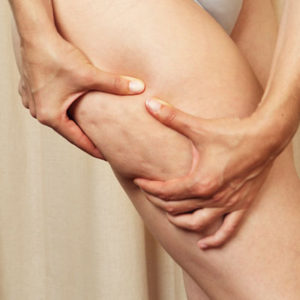Its name makes it sound like a medical condition. But cellulite is nothing more than normal fat beneath the skin. The fat appears bumpy because it pushes against connective tissue, causing the skin above it to pucker.
Cellulite isn’t harmful. Many people, though, would like to get rid of it because of the way it looks.
What Causes Cellulite[highlight_text]
Having cellulite doesn’t mean you are overweight. Even thin people can have it. If you are overweight, however, losing weight may reduce cellulite.
Cellulite is more common among women than men. If other women in your family have cellulite, there’s a good chance you will too.
Other factors that influence how much cellulite you have and how visible it is include:
Poor diet
Fad dieting
Slow metabolism
Lack of physical activity
Hormone changes
Dehydration
Total body fat
Thickness and color of your skin
Cellulite tends to be less noticeable on darker skin. If you have light skin and plan to be out in a bathing suit or short shorts, applying a self-tanner may make the bumps and dimples on your thighs less noticeable.
Cellulite Treatments
[/highlight_text]
There are many products and treatments that promise to get rid of cellulite on thighs and buttocks. But there is little evidence that shows that many of them work well or for long. Here is what you should know about some of the options:
Cellulite creams. These creams aresaid to dissolve fat and smooth the skin. But many cellulite creams contain aminophylline, a prescription drug approved for treating asthma. There is no scientific evidence that these creams are effective against cellulite, and for some people, they can be harmful. Their apparent effect on cellulite may be due to narrowing blood vessels and forcing water from the skin, which could be dangerous for people with circulatory problems. Aminophylline can also cause an allergic reaction in some people.
Liposuction. This is a surgical procedure to remove fat deposits from the body. Liposuction, though, removes deep fat, not cellulite, which is just beneath the skin. The American Academy of Dermatology warns that liposuction may actually worsen the appearance of cellulite by creating more depressions in the skin.
Mesotherapy. Mesotherapyis a therapy originally developed in Europe to relieve pain of inflammatory skin conditions. It involves injecting substances such as vitamins, minerals, amino acids, and enzymes into the tissue just beneath the skin. Mesotherapy may break down fat and bring a slight improvement in the appearance of cellulite. But it also carries risks, which include swelling, infection, and irregular contours.
Massage and spa treatments. Massage and other spa treatments may have a temporary effect on the dimpling appearance of skin. But they do not remove cellulite. Any effect is short-lived and probably due to the removal of excess fluid.
Laser treatment. The FDA has cleared the use of a device that uses laser energy to treat cellulite. According to the manufacturer, the device can melt fat under the skin, break up the fibrous bands under the skin, and stimulate collagen production.
What Lies Ahead in the Treatment of Cellulite
Although reviews of current therapies are mixed, doctors are always looking at new treatments for cellulite. One procedure involves using red and infrared light emitting diodes (LEDs) to emit certain wavelengths known to disrupt fat tissue, causing it to shrink. This procedure is combined with rollers and suctions to soften the fibrous bands of connective tissue that cause the dimpled appearance.
Although such procedures may hold promise for the future, for now, the best option is exercise, and, if needed, weight loss. Experts agree that the most effective exercise routine for cellulite is one that incorporates aerobic exercise and strength training along with a diet rich in fruits, vegetables, and fiber.
Reference of information:
http://www.webmd.com/healthy-beauty/cellulite-causes-and-treatments

